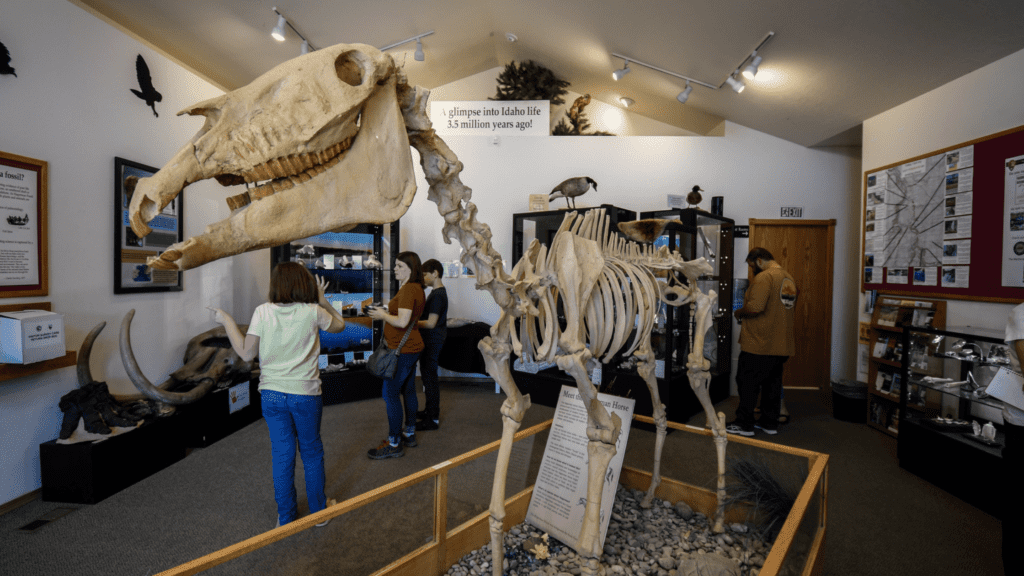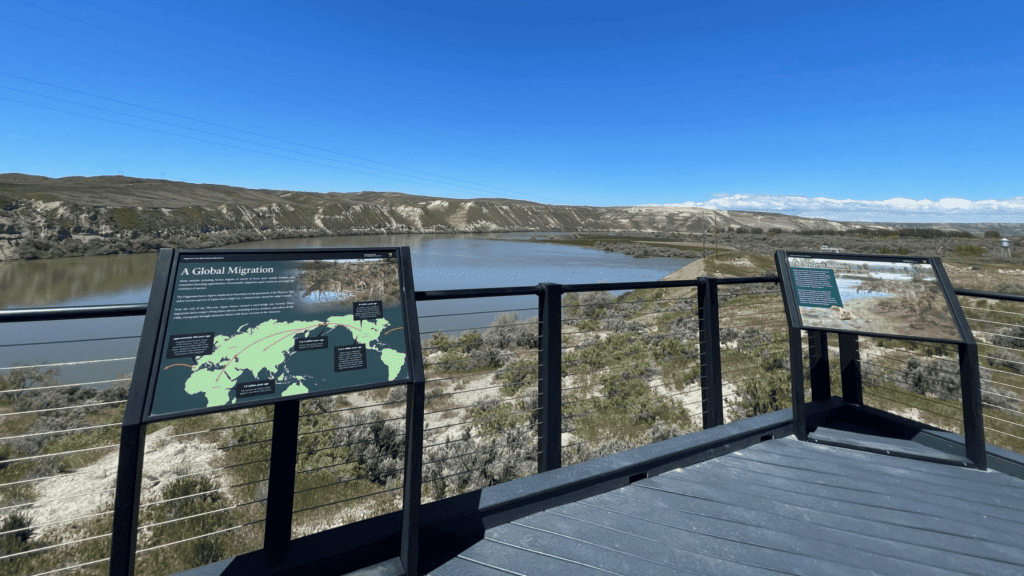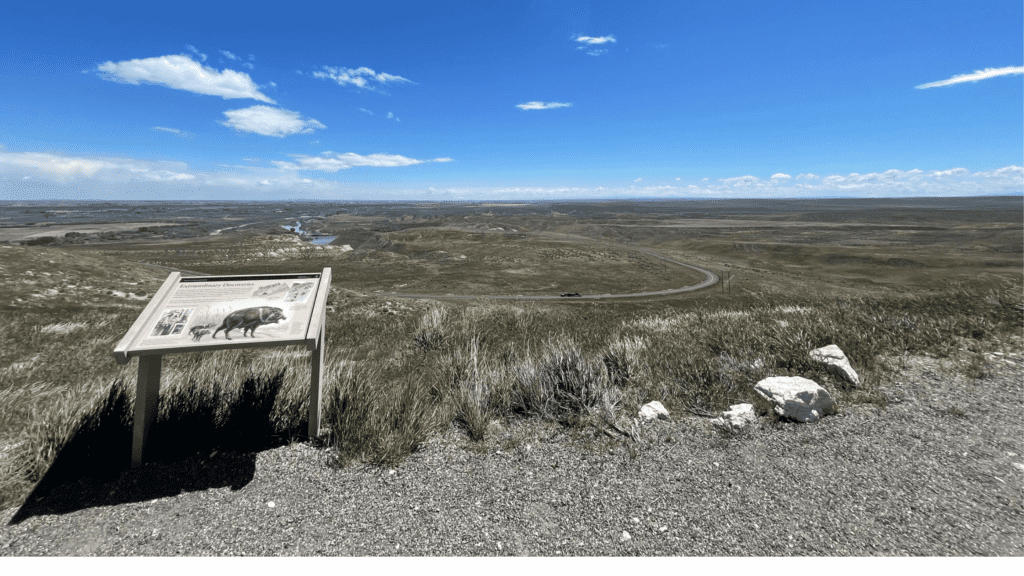
A treasure trove of ancient history is just waiting to be discovered at the Hagerman Fossil Beds National Monument. For paleontology enthusiasts, history buffs, and nature lovers alike, this site offers a fascinating journey back in time. The fossils discovered here have unlocked a lot about the Pliocene Epoch as well as the massive changes Hagerman has seen throughout history. You will definitely want to embark on an adventure to explore the wonders of this national monument.
Visiting Today
The Hagerman Fossil Beds are now housed in one of the National Park Service’s newest facilities. You’ll find the visitor center is a great place to start your adventure through the parks. The building houses both National Park’s and the Thousand Springs State Park’s staff, but also the monument’s fossils and educational resources. The combining of resources gives Hagerman the opportunity provide visitor information from one central location. They have fantastic staff, fascinating exhibits and the grounds are beautiful.

Walking inside you’ll find the fossil that made history, The Hagerman Horse. It was a pivotal discovery in piecing together the evolution of the horse as we currently know it. It is also Idaho’s official state fossil. There is an assembled fossil skeleton in the visitor center, at the Hagerman Historical Museum and in the Smithsonian in DC. The one at the visitor center dons a fun surprise on his nose. Make sure to get a selfie with the Hagerman Horse fossil.
You’ll also find many other fossils and interpretive items. Visitor Center hours do vary by season, so make sure to check their website. Located at the Billingsley Creek State Park, you’ll find an amazing walking trail, creek to float and campgrounds. From there, you’ll be directed to the Hagerman Bluffs to see the location of the fossil beds and the historic Oregon Trail.
Unearthing Prehistoric Treasures

The landscape, once inhabited by diverse prehistoric creatures, now reveals their fossilized remains. Scientists and interested explorers have been fascinated by this site since it’s official discovery in 1928. Before that, the Shoshonean people lived and hunted the banks of the Snake River likely discovering many fossils during their stays. From 1929 – 1931 and again in 1934 paleontologists came to excavate the area. In 1929 over 3 tons of fossils were sent to the Smithsonian in Washington DC to be researched and categorized. These fossils offer a glimpse into a world long gone. From the majestic mastodon to the fearsome saber-toothed cats, the fossils found here paint a vivid picture of life during the Pliocene Epoch.
One highlight of the park is the famous “Horse Quarry,” where the remains of over 200 fossilized Hagerman horses were discovered. These extinct equines, distant relatives of modern-day horses, roamed the region over 3 million years ago. Walking among the fossilized bones, you can’t help but marvel at the sheer magnitude of this one location.
Before delving into the bluffs, a stop at the monument’s main overlook is a must. Here, you’ll find signage about the geology and paleontology of the area. They aim to help uncover the mysteries locked in the bluffs and Snake River below. The overlook is quite scenic and provides a great view of the river and valley. There are drop toilets and access across the road to the park’s main hiking trail.
Exploring the Trails

Armed with newfound knowledge, it’s time to hit the trails and explore the fossil-rich landscape firsthand. The monument offers several well-marked hiking paths, each leading to different fossil sites and scenic viewpoints. The main hike follows the Emigrant and Oregon Trail. Travelers can not only imagine a time when ancient ground sloths and giant mastodons walked here, but also when emigrants braved the harsh west to reach a new future. Don’t worry, you can opt for a leisurely stroll or a more challenging hike. Either way, you’re bound to encounter remnants of life long ago along the way.
The main hike is Emigrant Trail to Oregon Trail and Snake River Overlook. It is 6.8 miles long and winds behind the main fossil bluffs and Snake River. Views of the valley stretch out behind trekkers as they climb the canyon hill to the top. There is an approximate 698′ elevation gain. This trail has no shade along the way, so early morning or later afternoon hiking would be advisable during the summer months. Please be sure to pack water and sunscreen.

A smaller hike at the top of the monument branches off into several overlooks and wayfinding areas. In the spring wildflowers bloom and the trails are quite beautiful. Visitors can find history from the Pliocene Epoch as well as the Oregon Trail and more in the area. There is a shade pavilion near the parking lot and would be a great place to bring a packed lunch.
Wildlife and Natural Beauty
Beyond its paleontological significance, Hagerman Fossil Beds National Monument is also a haven for wildlife and natural beauty. Keep your eyes peeled for bald eagles soaring overhead, beavers and waterfowl near the river and lizards and jackrabbits along the bluffs. The stunning vistas of the Snake River Canyon provide a breathtaking backdrop for your outdoor adventures.
Preservation and Education
As stewards of this remarkable site, it’s essential to recognize the importance of conservation and education. The staff and volunteers at Hagerman Fossil Beds work tirelessly to preserve its delicate ecosystems. They ensure that future generations can continue to enjoy and learn from its wonders. Through guided tours, educational programs, and ongoing research initiatives, they strive to promote a deeper understanding of Earth’s natural history.
A visit to Hagerman Fossil Beds National Monument is not just a journey through time – it’s a celebration of Earth’s rich tapestry of life. From towering mastodons to tiny fossilized insects, each discovery tells a story millions of years in the making.
